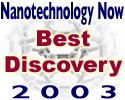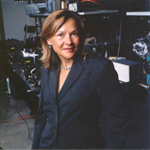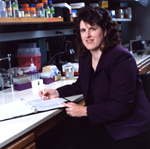Home > Best of Nanotechnology > 2003 > Best Discoveries
Best Discoveries
Last Updated: Monday, 20-Apr-2015 19:51:36 PDT
For the past six years the team at Nanotechnology Now has tracked the thousands of websites, individuals, businesses, and government and educational institutions that exist in the nanospace. We read about and report on them every day, 365 days a year. By interviewing them, and covering their news, opinions, discoveries, triumphs and failures, we have come to appreciate a few above the rest.

|
"Imagine if cancer could become trivial." Naomi Halas
For furthering our understanding of the potential of "nanoshells," while at the same time lessening our worries about cancer, this year's "Best Discovery" Award goes to Naomi Halas and Jennifer West for their cancer-fighting gold nanoparticles. One of their visions: no less than single visit diagnosis and treatment of cancer.
|

Dr. Naomi Halas
|

Dr. Jennifer West
|
|
Their tool: a 100 nanometer (nm) gold sphere or "nanoshell" surrounding a silica core. How big is 100 nm? Take a look at the period at the end of this sentence - it's about 10,000 times bigger than a nanoshell.
The process: during your regular checkup, your doctor injects you with nanoshells, then shines a "near-infrared" light over your body, briefly. Then a program on their laptop indicates location, shape and size of any new early-stage tumors. Once located, each tumor can then be hit with the same light, at higher energies, killing the tumor, and not damaging the surrounding tissues.
To kill a tumor, what do the nanoshells and light do? In a nutshell, they "cook" it. How does it work: The gold coat of the nanoshell absorbs the externally applied light-energy, turning it into heat (up to 131 degrees F.) So far it has worked on human breast tissue cancer cells, and tumors on mice.
The upsides: Single-visit diagnosis and treatment, and significantly less damage to non-cancerous tissues (Popular Science writer Kevin Kelleher said it best: "Today's best cancer treatments destroy tumor cells with about as much precision as an atomic bomb.") And last, but not least, after serving their purpose, nanoshells are eliminated from the body, naturally. (Silica-gold nanoshells are [also] uniquely suitable for use in 'instantaneous' whole-blood immunoassays, and optically triggered drug delivery.) Ed. Note: This simple, painless, quick therapy may replace or supplement chemotherapy and surgery. Personally, I could do without the worries, nausea and cost of conventional therapies.
The downside: You'll have to wait until clinical trials are passed, and the FDA has their say, which could take …
For more, read the report Nano Cancer Fix from ScienCentral (with video).
The DoD Breast Cancer Research Program believes in them, awarding a four-year $3M Innovator's Grant towards development. Their work is also supported by the National Science Foundation, the Army, Navy and Air Force.
And let us not forget their work in improving the immunoassay process. The upshot: "... a new method of testing whole blood that could allow emergency room doctors and other point-of-care health professionals to rapidly diagnose a variety of ailments, including hemorrhagic stroke, heart attack, and various infectious diseases." See Rice makes first rapid, sensitive whole-blood immunoassay for details.
For their efforts to help insure a brighter future for cancer victims, we present to Naomi Halas and Jennifer West the "Best Discovery" award for 2003.
|
"Nanoshells eventually may find a role in emergency rooms and doctor's offices, too. The group is in the early stages of developing a nanoshell-based blood test for detecting diseases and the telltale signs of stroke. Their goal is to make an on-the-spot and accurate diagnostic tool for medical personnel.
Not one for hyperbole, Halas uses the words "revolutionary" and "frontier" to describe how nanoshells could affect medical products and procedures. 'This could change the way people think about surgery and diagnostics,' she says." Small Times
|
|
"The researchers hope to develop nanoshells as a platform technology for the integrated discovery, diagnosis and treatment of breast cancer. Ultimately, they hope to enable doctors to find cancerous lumps six to seven years earlier than they can with today's mammograms. They also hope nanoshell technology will allow doctors to diagnose those lumps without invasive biopsies and destroy malignant tumors without surgery.
Unlike drug-based cancer therapies, the photothermal treatment of cancer relies on the basic physics of light. By shining near-infrared light on gold nanoshells, doctors can generate enough heat to burst the walls of tumor cells. The light itself is invisible and harmless, and because the heating is very localized, it affects only cells immediately adjacent to the nanoshells. The use of benign, light-activated nanoshells avoids many of the side effects of chemotherapy and radiation, which often affect healthy tissues and make patients sick."
Ellerbee honors 'all-girl cancer-killer team'
|
For more information, see:

Nanospectra LLC and Nanospectra Biosciences
Nanoshells: gifts in a gold wrapper
Rice develops nanosensor for precision chemical analysis
Startups seek perfect particles to search and destroy cancer
Nanoshells, buckyballs and other tools
And a nice profile of Dr. Halas by Candace Stuart, Small Times Features Editor Gold Metal Aspirations
|



